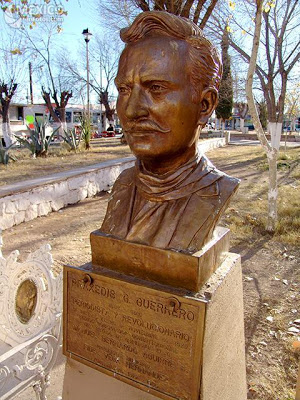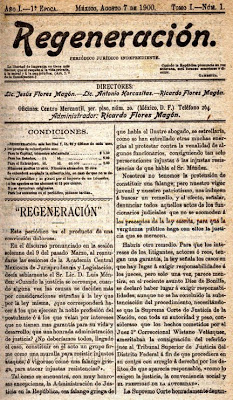
‘The breath of the revolution’:
Wave of anarchist bombings hits Mexico;
Security forces on red alert
By John Ross / The Rag Blog / October 5, 2009
MEXICO CITY — An unprecedented wave of anarchist bombings here and in provincial capitals has Mexican security forces on red alert.
Beginning September 1st, bombs have gone off once or twice a week regularly as clockwork, taking out windows and ATMs at five banks, torching two auto showrooms and several U.S. fast-food franchises plus an upscale boutique in the chic Polanco district of this conflictive capital. In each case, the Anarchist “A” has been spray-painted on nearby walls along with slogans supporting animal liberation, demands to stop prison construction, and calls for the demise of capitalism.
The serial bombings are the first to strike Mexico City since November 2006 when radicals took out a chunk of the nation’s highest electoral tribunal, blew a foreign-owned bank, and scorched an auditorium in the scrupulously-guarded compound of the once and future ruling PRI party.
The 2006 attacks came in the wake of a fraud-marred presidential election and federal police suppression of a popular uprising in the southern state of Oaxaca and were claimed by five armed groups, most prominently the Democratic Revolutionary Tendency, a split-off from the Marxist-Leninist Popular Revolutionary Army (EPR) which itself bombed a Sears outlet in Oaxaca City in 2006 and PEMEX pipelines in central Mexico in 2007.
Anarchist cells that claim to have perpetrated the recent explosions take pains to distance themselves from the Marxist bombers.
In vindicating a September 25th blast at a Banamex branch in the rural Milpa Alta delegation (borough) of Mexico City during which the rebels claim a half million pesos were immolated, “The Subversive Alliance For The Liberation Of The Earth, The Animals, & The Humans” (in that order) charged that the U.S.-owned bank promoted “torture, destruction, and slavery. “Our motives are to stop these bastards and let them know that we are not playing games.”
Bank video cameras captured the images of three hooded and black-clad young bombers. On October 1st, 22 year-old Ramsis Villareal, a student activist, was arrested by federal police and charged with “terrorism” in connection with bombings at several of the banks. He was released the next day after violent protests by young anarchists in Mexico City.
The September 25th Banamex blast was not the first time the bank has been targeted by “terrorist” bombs. In August 2001, heavy duty fireworks broke out windows in a “cristalazo” at three southern Mexico City branches to protest the sale of Banamex, Mexico’s oldest bank, to Citigroup, the New York-based banking group that has been so devastated by the financial melt-down that it recently put Banamex back up for sale.
The 2001 bombing was attributed to the little-known Armed Revolutionary Front of the People (FARP). Three brothers, students at the UNAM, and the sons of EPR founder Francisco Cerezo (not his real name), were subsequently imprisoned on “terrorism” charges — the attacks took place just days before the terrorist assaults on New York and Washington purportedly carried out by Osama Bin Laden’s Al-Qaeda group. The Cerezo brothers were imprisoned for eight years and have only recently been released from federal lockup.
The September bombings and associated property damage also singled out Mexico City and Guadalajara offices of the European bio-tech titan Novartis that, along with Monsanto, bears responsibility for spreading genetically modified seed throughout Mexico’s corn-growing belt and contaminating native species of maiz. Auto showrooms in the two cities were also on the business end of Molotov cocktails September 18th and 26th — seven luxury automobiles including a Hummer were torched at Auto Nova in Guadalajara.
An Internet page documenting the Guadalajara bombing included communiqués from Jeffrey Luers AKA “Free,” who is serving ten years in Oregon for burning up 21 SUVs on a Portland lot. “Free” is accused by the FBI of being an associate of the Earth Liberation Front, eco-“terrorists” that the U.S. Justice Department has elevated to the top of the Terrorist Hit Parade, alongside Bin Laden. The initials “ELF” were reportedly spray-painted on the burnt-out showroom walls.
Messages justifying the bombings were posted to the Total Liberation website that is dedicated to “the dissolution of civilization” and serves as an international bulletin board for notices of similar sabotage by anarchist cells around the world such as the U.S. “Burn Down The Jails!,” Latin American autonomous cells of the Animal Liberation Front — an ELF offshoot, and the Greek anarchist movement that ravaged Athens this summer.
“Our fire illuminates the night!” waxed poetic one anonymous Mexican anarchist interviewed on the Total Liberation site. “We have lost all fear of spending the rest of our days in prison,” perhaps a reference to the Cerezo brothers and Ramsis Villareal. Groups claiming bombings, and other successful acts of sabotage take fanciful names infused with poetry, bravado, and black humor: “Luddites Against the Domestication of Wildlife,” “Espana Signus Francescos” (thought to be a reference to San Francisco of Assisi, the patron saint of animals), and “Autonomous Cells of the Immediate Revolution — Praxedis G. Guerrero.”
The historically obscure Guerrero was the first anarchist to fall in the landmark 1910-1919 Mexican revolution whose centennial will be marked in 2010. Praxides G. Guerrero was felled by a “bala ciega” (literally “blind bullet”) during a guerrilla raid on Janus Chihuahua in May 1910, six months before Francisco Madero officially called for the overthrow of dictator Porfirio Diaz in November of that year to launch the Mexican revolution.
Only 28 years old on the day of his death, Guerrero was a young partisan of anarchist superstars Ricardo and Enrique Flores Magon. “Praxedis translated the theory of anarchism into practical action,” writes anarchist historian Dave Poole. In a recent e-mail, John Mason Hart, author of the definitive study “Anarchism & The Mexican Working Class,” concluded that if Guerrero had survived, the Mexican revolution would have looked more like the contemporary neo-Zapatista rebellion in Chiapas than the fratricidal bucket of blood it became.
As a writer, Praxedis G. Guerrero’s prose has all the impact of an anarchist bomb. In “Blow!” the revolutionary imagines himself as the wind: “I steal into palaces and factories, I blow through prisons and caress the infancy prostituted by Justice, I force my way into army barracks and see in them an academy of assassination, I am the breath of the revolution…”
It hardly seems a coincidence that modern-day anarchists struck in September, “the patriotic month” when Mexicans celebrate the declaration of their independence from Spain in 1810, the bicentennial of which, along with the centennial of the Mexican Revolution, is on deck in 2010.
President Felipe Calderon has budgeted billions of pesos to mark the twin centennials even as Mexico is mired in a bottomless recession that has driven millions of workers into the streets. Ironically, the Calderon government has reportedly contracted a Hollywood production outfit with the very anarchist brand-name “Autonomy” for $60,000,000 USD to mount centennial “spectaculars” — in 2008, “Autonomy” staged the spectacular pageant that opened the Beijing Olympics.
In invoking Praxedis G. Guerrero’s hallowed name, anarchist bombers appear to be celebrating the vital role their ideological forbearers played in the Mexican revolution, the first great uprising of the landless in the Americas and an immediate precursor of the Russian revolution.
Anarchism in Mexico dates back to the first days of the republic when in 1824, North American followers of the Welsh utopian socialist Robert Owen unsuccessfully sought to establish colonies along the border in Chihuahua. In the 1860s, anarchism doing business as “mutualism” (i.e. working class solidarity) took root in the burgeoning Mexican labor movement — mutualism’s most significant representation was the House of The World Worker (“Casa de Obrero Mundial“) that flourished during the early days of the revolution.
As the Mexican revolution crested at the turn into the 20th century, anarchism gained an early foothold. Ricardo and Enrique Flores Magon’s newspaper Regeneracion (“Regeneration”) was passed from hand to hand and widely read by those who sought the dictator’s overthrow. Repeatedly imprisoned by Porfirio Diaz, Ricardo and Enrique fled to the U.S. where they clandestinely continued to publish Regeneracion.
The anarchist duo was pursued by both Diaz’s agents and U.S. immigration authorities and forced to flee from city to city (San Antonio, Los Angeles, St. Louis.) Imprisoned for violating the 1917 version of the Patriot Act, Ricardo Flores Magon died in Leavenworth Federal Penitentiary in 1922 under mysterious circumstances that suggest he was strangled by prison guards for flying a Mexican flag in his cell. A century after the Mexican revolution, a handful of campesino organizations in the Flores Magones’ native state of Oaxaca continue to incorporate the brothers’ names in their struggles.
During their ill-fated sojourn north of the border, the Magones forged links to U.S. anarchists. The IWW — the Industrial Workers of the World or Wobblies — which preached anarchism on the street corners of the American west, is said to have been the organizing force behind the miners’ strike in the great Cananea copper pit in Sonora during which a score of workers were massacred by the Arizona Rangers — Cananea is considered the seedbed of the Mexican labor movement. The celebrated Chicago anarchist Voltairine de Cleyre contributed to Regeneracion and raised bail money for the Flores Magones. In 1911, Joe Hill, the renowned Wobbly organizer and bard, rode with the Magonistas in a failed expedition to liberate Baja California.
Despite their margination from the revolutionary mainstream, Magonistas fought in the armies of Emiliano Zapata, Francisco Villa, and Venustiano Carranza although they were often singled out as troublemakers and executed by revolutionary firing squads.
The anarchist flame in Mexico would never have survived without the solidarity of Spanish exiles. Spanish anarchists played a critical role in the formation of the House of the World Worker and after the Spanish Civil War (1936-9) anarchist fighters and thinkers were offered sanctuary from Franco’s fascist hordes in Mexico. Spanish anarchists founded the Social Reconstruction Library in downtown Mexico City, an invaluable repository of anarchist archives.
The Zapatista rebellion in Chiapas in 1994 signaled the second coming of Mexican anarchism. The EZLN’s rejection of dependence on the “mal gobierno” (bad government) and its insistence on collective action and the creation of autonomous zones in the southeast of that highly-indigenous state inspired collectives of young anarchists, often clustered around the National Autonomous University or UNAM. Anarchist activists spurred the 1999-2000 strike against a tuition hike at the National University. Ski-masked, so-called “ultras” with tags like “El Mosh,” “El Gato,” and “The Devil” drove the student struggle to sectarian excess and a clampdown by the federal police that resulted in 700 arrests.
The uproar at the 1999 Seattle conclave of the World Trade Organization was the first explosion of the anti-globalization movement in which anarchists would play a pivotal role. Black clad youth basked in the media spotlight in Seattle but property damage against franchise chains like Niketown by the self-named “Black Bloc” purportedly animated by the writings of U.S. anarchist guru John Zerzan, offended mainstream anti-globalization groups like Global Exchange whose founder Medea Benjamin called for their arrest. The Seattle uprising was first plotted at a 1996 anti-globalization forum staged by the Zapatistas on the fringes of the Lacandon jungle.
The death of Black Blocker Carlo Giuliani under the guns of the police at the 2001 Genoa Italy G-8 summit had deep scratch in the Zapatista zone where a clinic has been named for the anarchist martyr at Oventic, the rebels’ most public outpost — the Giuliani family has contributed an ambulance.
Mexican black blockers went into action at the 2003 WTO fiasco in the luxury port of Cancun. Armed with Molotov cocktails, shopping carts filled with rocks, and home-made battering rams, the anarchos threatened to storm police barricades but spontaneous peace-making by indigenous women protestors helped avoid bloodshed and the black-clad militants decided to burn down a local pizza parlor instead.
Bloodshed was on the agenda at a 2004 Ibero-American summit in Guadalajara when then Governor Francisco Ramirez Acuna (now president of the lower house of the Mexican congress) unleashed his robocops on an anti-globalization rally. Young anarchists were beaten into the sidewalk like so many baby harp seals and dragged off to gaol where police torture continued for weeks. Several block blockers were held for nearly a year despite the outcry from the international human rights community.
Anarchist collectives in Mexico City are not universally unruly. La Karakola, a collective that swears allegiance to Zapatismo and non-violence, would just as soon dance as toss rocks at the cops. Anarcho “squats” take over abandoned buildings — the “okupas” modeled on those run by Barcelona activists pop up in unlikely neighborhoods such as the squat house under the towering Torre Mayor, an 88-story skyscraper on swanky Reforma boulevard.
Punky anarchist fashion — black clothes, studded leather jackets, piercings, exotic hairstyles, and a written language in which “k’s” replace “c’s”, is popular with dissident big city youth and on display Saturday mornings at the Chopo Bazaar and evenings at the Alicia Forum where punk meets anarchism. But most anarcho “fashionistas” are not bombers — it’s a struggle to slip a ski mask over a Mohawk.
2006 seems to be the year that anarcho fury at the destruction of the planet took wings — the earliest postings on the Total Liberation page date from then. The first actions were little publicized and dismissed by police and the media as vandalism — destruction of pay phones installed by Telmex, owned by tycoon Carlos Slim, the richest man in Latin America, is a popular sport. Sabotage peaked in 2008 when 129 actions were recorded, most of them non-violent such as the liberation of slaughter house-bound chickens and the reconfiguration of bull ring signage transforming the Toluca Plaza de Torros into a “Plaza of Torturers.”
One exception was the torching of a leather expo in Leon Guanajuato, the shoe and boot capital of Mexico. On October 2nd, the 40th anniversary of the 1968 student massacre, fast food franchises were Molotov-ed in the capital’s old quarter and 13 anarchists arrested. Fake bombs were subsequently planted at MacDonald’s, KTC, and Burger King in ten provincial cities.
The September wave of bombings was a defiant step upwards but not by much — the “bombs” were primitively fashioned from butane tanks used by plumbers to solder pipes and detonated by bottle rockets. All bombings occurred during early morning hours to avoid human casualties although some stray dogs and cats may have been singed.
Despite the lack of lethal intent, the bombings have riveted the attention of numerous security forces, particularly the CISEN, Mexico’s lead intelligence agency which is reportedly spread thin trying to keep tabs on plans by clandestine guerrilla bands ranging from the Zapatistas to the EPR to foment armed uprising during the 100th birthday party of the Mexican revolution to which all Mexicans, regardless of ideological persuasion, have been invited.
[John Ross’s monstrous El Monstruo — Dread & Redemption In Mexico City will be published this November by Nation Books. Iraqigirl, the diary of a teenager growing up under U.S. occupation, is already in the stores. The author will be touring with both volumes in 2009-2010 and invites suggestions of venues at johnross@igc.org.]




















Bravo!
It’s better to die upon your feet than to live upon your knees!
Che Guevara
Prefiero morir de pie que vivir de rodillas.
-Zapata
There you go. The prefect way to see the truth behind this blog site. Death and destruction to all who disagree. Those who fail the pass the “true believer” test are fair game.
Oh, right, like the Dixie Chicks were fair game…or all the people Bush put in jail as terrorists for speaking…how about Mr. Arar, that Bush send to Syria to be tortured and Canada found him totally innocent.
You right wingers have forfeited the jail and torture game, you know. No one listens to your pontifications on that subject anymore.
Not only did you DO IT, but you still defend it and make it very clear you’d like to keep on doing it…so don’t attack “leftists” for any of that. Even if they do it, so the hell do you.
Well said Fed Up
JoJo,
You are correct,it was Zapata,I was mistaken.
However the ideal was and is carried on.
pms
Uh, actually “It is better to die on your feet, than live on your knees” was from a poem by José Marti.